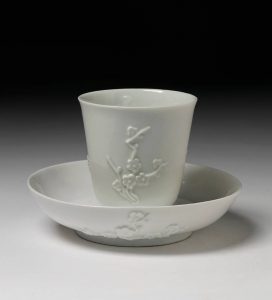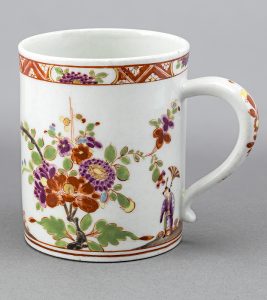It was Marco Polo’s tales of his years spent in the Middle Kingdom that captured Europe’s imagination with amongst many things, Chinese porcelain. A small jar, now in St Mark’s Bascilica in Venice is believed to have been bought back by Polo in 1295 and is thus the first known Chinese porcelain to have reached Europe. Polo termed Chinese porcelain, porcellena after the gleaming white cowry shells it resembled.
Whilst the Portuguese and British had been trading extensively with China as early as the sixteenth century, the Dutch, French and British East India Companies later began importing large quantities of Chinese and later Japanese and Korean porcelain into the UK and Europe. These ‘Asian’ imports were referred to in the West as ‘China’ and were in high demand by the wealthy elite.
Whilst porcelain had been known in Europe since the thirteenth century it continued to be imported from China centuries later. We know the Chinese had been producing porcelain since 600 AD and kept both the recipe and method of production a closely guarded secret. Europe had no knowledge of its production and alchemists set about experimenting to produce this ‘white gold’.
Augustus the Strong of Dresden, Germany was an avid collector of East Asian ceramics and began collecting thousands of pieces that were destined to be eventually displayed in a specially commissioned pavilion known as the Japanese Palace. Fortunately for us this unique collection is on display at the Zwinger Palace in Dresden. A porcelain enthusiast’s dream.
Meissen Porcelain. Europeans tried to copy Chinese porcelain for centuries but only in 1709 managed to create real porcelain – in Dresden, Germany. Meissen Porcelain.
Augustus the Strong, like many others was determined to discover the secrets of porcelain’s hardness and translucence. Such was his obsession, he literally imprisoned two of the most capable alchemists and instructed them to discover the recipe and keep their findings confidential. In 1709, after years of research, the physicist E.W von Tschirnhaus and the alchemist J.F Böttger succesfully discovered and produced hard-paste porcelain in Germany. This lead to the foundation of the Saxon Royal factory, Meissen the following year.
The early Meissen factory enjoyed financial support from Augustus the Strong and achieved a monopoly in Europe in the production of porcelain. In time, Meissen came to be favoured more than the Asian porcelain imports. In examining these early pieces one can see why.

Meissen made imitations of East Asian porcelain whilst at the same time reinvented forms and patterns suited to the European taste. Some pieces, such as the beaker and saucer above, now in the V&A collection are so well made, they are almost indistinguishable from Chinese originals.
Design Transmission and Creation of a new Style ‘Indian’ flowers on Meissen Porcelain
The Meissen factory would be sent Chinese or Japanese porcelain from the collections of Augustus the Strong with instructions to copy the decoration of these originals. Böttger took castings directly from Chinese originals and in part used them as models. To say that early European porcelain owed a stylistic debt to East Asian originals is an understatement.
Johann Gregorius Horoldt (1696-1775) was a painter at the royal court in charge of painting at the Meissen factory. Horoldt’s painting during his early phase were heavily influenced by East Asian modes and motifs. He is famed for his fantasy world chinoiseries influenced by Chinese and Japanese artefacts. Alongside these, under his direction, were created decorations of fleurs des Indes – flowers of the Far East usually ‘enlivened’ by the presence of brightly coloured birds and insects or animals. Through experimentation he developed techniques to make the porcelain whiter so as to better display the range of enamel colours he introduced, greens, yellows, purples and browns.

The above pattern ‘Indian flowers’ Indianische Blumen is one of the oldest decorative motifs applied to Meissen porcelain dating back to 1720. East Asian stylistic references are described as ‘Indian’ as East Asian porcelain was shipped to Europe by the East India Companies and stylistically bear little or no relation to India. This pattern became a signature style of Meissen and continues to be used today.
Visit
